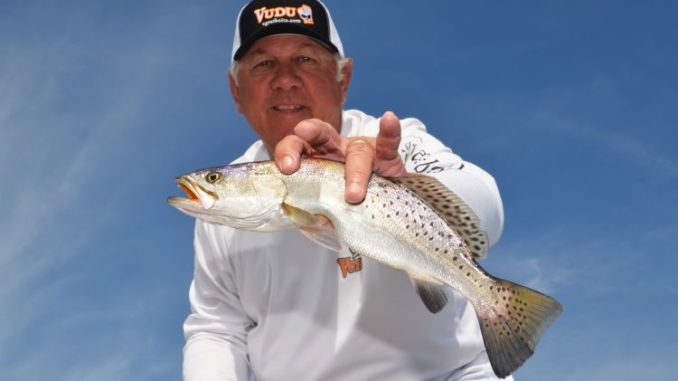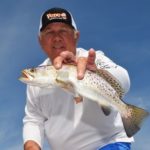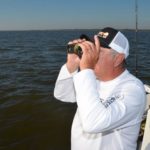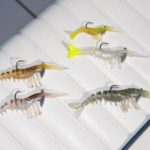
Tightlined or under a cork, the Vudu Shrimp is big fall bait on Big Lake
I’ve known Ken Chaumont a long time. As an outdoors writer, it’s hard not to know him — likely one of the 10 most prominent names in Louisiana fishing today.
To me, he was always “Mr. Rat-L-Trap,” the gregarious and friendly guy who was the face of the enormously popular bass and saltwater lure.
Then along came this Vudu Shrimp thing which swept the speckled trout fishing community. To my surprise, he was the one behind Egret Baits, the maker of Vudu Shrimp.
So I hunted an invitation from him to learn how to master the lure.
“Come in the fall,” he said expansively. “That will be perfect. That time of year in Calcasieu Lake there is a lot of bird activity (gulls diving on schools of feeding speckled trout).
“They just aren’t as big as they used to be. Bird trout used to average 1 ½ pounds, but this is the third year of small fish. People are asking, ‘This is unbelieveable. When are they ever going to grow up?’
“But there will be plenty of them.”
We launched at Calcasieu Point Boat Launch, a beautiful public launch operated by the Calcasieu Parish Police Jury just outside of Lake Charles. Chaumont’s prediction was that speckled trout would already be in Turner’s Bay at the north end of the big lake or in Lake Prien.
Both are favored wintering spots for the quicksilver predators.
We got there too early for gulls to be working actively, so Chaumont passed the time walking the dog with black-backed clear Zombie Ghost Walker surface lure, also made by Egret.
Following my line of questioning about Vudu Shrimp, the reason I was there, Chaumont explained that selecting a size is the first step. The lure comes in four sizes as well as 60 different colors.
The Original Vudu Shrimp is 3 ¼ inches long and designed to ideally be fished under a weighted cork. Egret makes oval- and cone-shaped corks which have a shorter stainless wire than other corks. The shorter wire makes them easier to cast and requires a shorter stroke when being worked. The lure itself also carries a ¼-ounce weight which aids in casting.
Slightly larger is the Vudu Rattler at 3 ½ inches long. The lure is built with a bulkier body to accommodate a rattle. It can also be fished under a cork, but is often used tightlined to bounce off the bottom and is a good muddy water lure.
Biggest in the clan is the Jumbo Vudu, at 4 inches with a 3/8-ounce weight, which he calls “a number one big trout bait.” The extra weight adds casting distance. The lure is also useful during the period in the shrimp season when shrimp have grown larger.
Last in the lineup is the Baby Vudu. It is only 2 inches long and weighs 1/8-ounce. Chaumont likes it for fishing under dock lights at night. He noted the Baby Vudu has gained favor in Florida amongst bonefish anglers.
Chaumont’s surface lure didn’t seduce any specks but a scrappy redfish smashed it. With the fog finally burning off of the lake, Chaumont picked up his binoculars and carefully scanned the lake for signs of feeding birds.
“Binoculars are important for this kind of fishing. They save a lot of gas,” he said matter-of-factly. It wasn’t long before he spotted diving sea gulls.
He maneuvered the boat upwind of the feeding gulls with his big motor. Well away from the working birds, he turned off his engine and trolled into casting distance with his trolling motor.
“The number of birds is no indication of the size of the fish school beneath,” he noted. “Just one bird circling means something. It is seeing something we don’t see.
“Even birds sitting on the water is worth a drift. The fish just haven’t pushed the bait school up to the top, but the birds are following the fish. They can see the trout beneath them, absolutely.”
He immediately hooked up on a trout. Fishing fast, he took several fish before another boat zeroed in on the spot. For whatever reason, the birds scattered making pinpointing the school of fish impossible.
Chaumont moved away and watched until he spotted another melee of screeching gulls. The same scenario was repeated, with a different boat shutting the party down this time.
Obviously, other people have binoculars, too.
Different boats beat him to the next couple of flocks, so they had first choice of position, which is all-important in fishing bird trout. Rather than put the birds down by coming in at a poor angle, Chaumont moved away to find his own fish.
“The competition from other boats gets pretty strong,” he muttered.
Chaumont fished his Vudu Shrimp both under a cork and without a cork. “Corks produce more fish in numbers, generally speaking, but a lot of time they can be smaller.
“I go to tightline to let the lure sink beneath the school of fish to pick up larger ones. Fishing tightline also lets you make more casts and cover more water because the retrieve is faster”
He clearly seemed to favor a cork today though. He sets his cork to fish 18 inches deep year round. “I don’t like to fish deeper,” he said. “It’s harder to cast and there usually isn’t any reason to fish deeper.”
He bopped from flock to flock for several hours, picking up one or two fish from each one when he could beat the other boats to the action.
“It’s hard now to catch a lot of trout from under a flock of birds. You have to hit 25 flocks to catch 50 fish. Years ago, you might catch a hundred from one school. I think it’s because the schools are smaller — 30 or 40 fish instead of 400,” he ventured.
“I absolutely think that the Calcasieu fishery is not as good as it used to be. I hate to use the word ‘overfished,’ but every school has two boats on it.
“I think there’s an issue with the food base, too,” he went on. “We used to have larger shrimp. Now they are all like this (he spread his fingers 1 ½ inches apart). The trout are smaller than they used to be, too. The late 1980s to the mid-1990s were something. Now they are little dinks.
“A lot of old-timers say we need another storm to shake things up. After (Hurricane) Rita, the lake just lit up.”
By mid-day, the tide went slack and the birds hunkered down. Chaumont beat the bank with his Vudu to pass the time until the tide turned.
When it did, the action was better. “All the other boats have left the lake, so we’ll have the schools to ourselves,” he smirked. Six trout came out from under the first flock of birds.
Chaumont provided a tutorial on boat positioning for bird fishing while he worked the willing fish.
“An important part of positioning is deciding whether to close in on a flock or not. Two boats is enough. I’ve seen five trying to work one flock, but that’s not good etiquette.
“Set up on a flock so that the wind doesn’t cause the boat to drift right through them. Use your trolling motor to keep the boat positioned to work the edge of the birds and fish.”
Very windy days are a problem because of wave slap and the trolling motor coming out of the water, he noted. Under these conditions, he recommends anchoring or hitting the anchor button on an I-Pilot.
“Let the boat swing around stern toward the flock and fish out of the stern. You have to pick up the anchor or release the I-Pilot when fish move, hopefully to drift back into casting range.”


